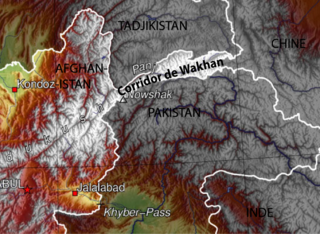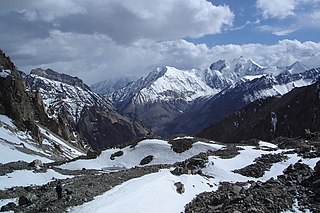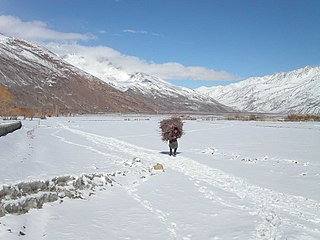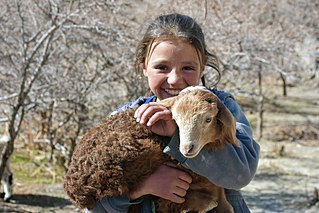Related Research Articles

The Amu Darya is a major river in Central Asia and Afghanistan. Rising in the Pamir Mountains, north of the Hindu Kush, the Amu Darya is formed by the confluence of the Vakhsh and Panj rivers, in the Tigrovaya Balka Nature Reserve on the border between Afghanistan and Tajikistan, and flows from there north-westwards into the southern remnants of the Aral Sea. In its upper course, the river forms part of Afghanistan's northern border with Tajikistan, Uzbekistan, and Turkmenistan. In ancient history, the river was regarded as the boundary of Greater Iran with "Turan", which roughly corresponded to present-day Central Asia. The Amu Darya has a flow of about 70 cubic kilometres per year on average.

The Kyrgyz people are a Turkic ethnic group native to Central Asia. They are primarily found in Kyrgyzstan, Uzbekistan, China, Pakistan and Afghanistan. Kyrgyz Diaspora is also found in Russia, Tajikistan, and Kazakhstan. They speak the Kyrgyz language, which is the official language of Kyrgyzstan.

The Wakhan Corridor is a narrow strip of territory in Badakhshan Province of Afghanistan, extending to Xinjiang in China and separating the Gorno-Badakhshan Autonomous Region of Tajikistan from the Gilgit-Baltistan region of Pakistan. From this high mountain valley the Panj and Pamir rivers emerge and form the bigger Amu River. A trade route through the valley has been used by travellers going to and from East, South and Central Asia since antiquity.

The Pamir Mountains are a mountain range between Central Asia and Pakistan. It is located at a junction with other notable mountains, namely the Tian Shan, Karakoram, Kunlun, Hindu Kush and the Himalaya mountain ranges. They are among the world's highest mountains.

The Economic Cooperation Organization or ECO is an Asian political and economic intergovernmental organization that was founded in 1985 in Tehran by the leaders of Iran, Pakistan, and Turkey. It provides a platform to discuss ways to improve development and promote trade and investment opportunities. The ECO is an ad hoc organisation under the United Nations Charter. The objective is to establish a single market for goods and services, much like the European Union. After the dissolution of the Soviet Union, the ECO expanded to include Afghanistan, Azerbaijan, Kazakhstan, Kyrgyzstan, Tajikistan, Turkmenistan, and Uzbekistan in 1992.

Gorno-Badakhshan, officially the Badakhshan Mountainous Autonomous Region, is an autonomous region in eastern Tajikistan, in the Pamir Mountains. It makes up nearly forty-five percent of the country's land area, but only two percent of its population.

Wakhi is an Indo-European language in the Eastern Iranian branch of the language family spoken today in Wakhan District, Northern Afghanistan and also in Tajikistan, Northern Pakistan and China.

Wakhan, or "the Wakhan", is a rugged, mountainous part of the Pamir, Hindu Kush and Karakoram regions of Afghanistan. Wakhan District is a district in Badakshan Province.

The Wakhi people, also locally referred to as the Wokhik, are an Iranian ethnic group native to Central and South Asia. They are found in Afghanistan, Tajikistan, Pakistan and China—primarily situated in and around Afghanistan's Wakhan Corridor, the northernmost part of Pakistan's Gilgit−Baltistan and Chitral, Tajikistan's Gorno−Badakhshan Autonomous Region and the southwestern areas of China's Xinjiang Uyghur Autonomous Region. The Wakhi people are native speakers of the Wakhi language, an Eastern Iranian language.

Pakistan–Tajikistan relations are the foreign relations between Pakistan and Tajikistan.
Tajiks in Pakistan are residents of Pakistan who are of Tajik ancestry. The Tajiks are a Persian-speaking Iranian ethnic group native to Central Asia, living primarily in Afghanistan, Tajikistan, and Uzbekistan.

The Wakhjir Pass, also spelled Vakhjir Pass, is a mountain pass in the Hindu Kush or Pamirs at the eastern end of the Wakhan Corridor, the only potentially navigable pass between Afghanistan and China in the modern era. It links Wakhan in Afghanistan with the Tashkurgan Tajik Autonomous County in Xinjiang, China, at an altitude of 4,923 metres (16,152 ft), but the pass is not an official border crossing point. With a difference of 3.5 hours, the Afghanistan–China border has the sharpest official change of clocks of any international frontier. China refers to the pass as South Wakhjir Pass, as there is a northern pass on the Chinese side.
Ulupamir is a village in Erciş district, Van Province, Turkey.

The Little Pamir is a broad U-shaped grassy valley or pamir in the eastern part of the Wakhan in north-eastern Afghanistan. The valley is 100 km long and 10 km wide, and is bounded to the north by the Nicholas Range, a subrange of the Pamir Mountains.

Immigration to Pakistan is the legal entry and settlement of foreign nationals in Pakistan. Immigration policy is overseen by the Interior Minister of Pakistan through the Directorate General Passports. Most immigrants are not eligible for citizenship or permanent residency, unless they are married to a Pakistani citizen or a Commonwealth citizen who has invested a minimum of PKR 5 million in the local economy.
The Great Pamir or Big Pamir is a broad U-shaped grassy valley or pamir in the eastern part of the Wakhan in north-eastern Afghanistan and the adjacent part of Tajikistan, in the Pamir Mountains. Zorkol lake lies at the northern edge of the Great Pamir.
Karachukar Valley or Chalachigu Valley is a valley in Taxkorgan Tajik Autonomous County, Xinjiang, China. It contains the basin of the Karachukar River, a tributary of the Tashkurgan River, and is regarded as part of Taghdumbash Pamir. The valley borders Afghanistan to the west and northwest, Tajikistan to the north, and Pakistan to the south. The name of the valley is from Kyrgyz, meaning "black cave".

Wakhan National Park is a national park in Afghanistan. Established in 2014, the park comprises the entire district of Wakhan, extending along the Wakhan Corridor between the Pamir mountains and the Hindu Kush, bordering Tajikistan to the north, Pakistan to the south, and China to the east. Flora and fauna include some 600 plant species, the snow leopard, lynx, wolf, brown bear, stone marten, red fox, Pallas's cat, ibex, Marco Polo sheep, and urial. Remote and largely above the tree line, poaching and overgrazing, rather than mining and logging, currently pose the main threats. 13,000 Wakhi and 1,500 Kyrgyz live in the area.

Tegermansu Pass or Tigarman Su Pass is a closed mountain pass on the border between Afghanistan and China in Wakhan Corridor, in the Hindu Kush — Pamir mountain range. It is located between the Tegermansu Valley on the eastern end of the Little Pamir and Chalachigu Valley in Xinjiang, China. Historically, it was one of the three routes between China and Wakhan.
Pamir Kyrgyz is a dialect of the Kyrgyz language natively spoken in the Chitral district and Gojal Valley of Pakistan and Wakhan Corridor of Afghanistan. It has been evolving into a distinct dialect of Kyrgyz due to its isolation. The dialect is known by its speakers as Black Kyrgyz.
References
- 1 2 "Hermann Kreutzmann (2003) Ethnic minorities and marginality in the Pamirian Knot" (PDF). Archived from the original (PDF) on 2016-03-03. Retrieved 2011-04-19.
- ↑ The Kyrgyz of the Afghan Pamir Ride On: Ted Callahan
- ↑ "Afghanistan: Minorities make themselves heard - Afghanistan".
- 1 2 "Illegal immigrants a grave security threat". The Nation . 13 January 2010. Archived from the original on 16 September 2011. Retrieved 6 November 2010.
- ↑ Pakistani businessman to build natural juice factory in Jalal-Abad: AKIpress News Agency December 8, 2010
- ↑ "Kyrgyz from Pakistan intend to assist in development of tourism in the country". Asia Plus (Tajikistan). 31 July 2008.[ permanent dead link ]
- ↑ "Safe return of Pakistanis from Kyrgyzstan". Critical PPP. Archived from the original on 2011-07-26. Retrieved 2010-11-05.
- ↑ Tariq Ismail (19 June 2010). "Seeking refuge in Pakistan". The Express Tribune .
- ↑ Akhtar Jamal (10 October 2010). "Kyrgyz in Pakistan to vote today". Pakistan Observer .[ permanent dead link ]
- ↑ Turkey: Kyrgyz Nomads Struggle To Make Peace With Settled Existence